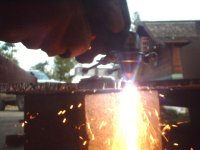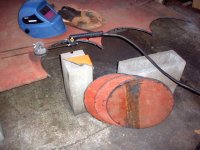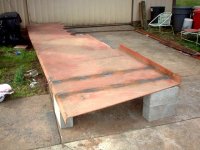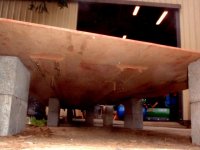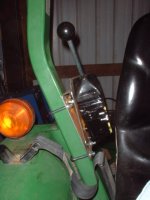You are using an out of date browser. It may not display this or other websites correctly.
You should upgrade or use an alternative browser.
You should upgrade or use an alternative browser.
Home-Made Circle-Jig for my Plasma Cutter
- Thread starter tomrscott
- Start date
- Views: 41091
More options
Who Replied?
/ Home-Made Circle-Jig for my Plasma Cutter
#11
billycalexander
Member
tell me more about "large speaker magnets" would they be good for mounting work lights to ROPS. I've got 2 magnets that came out of a microwave oven and they seem quiet strong but not sure how they compare to say 65 lbs magnets from http://hand-tools.hardwarestore.com/22-84-magnets-and-magnitizers.aspx.
And here's a shot of the under side of that plate, showing the remaining two angle brackets that I have to remove, like the one I already removed. Also a couple other reinforcing plates down there that I'll have to deal with. Once I get some more of this plate cut up, I am hoping it will get enough lighter that I can flip it over to make removing the last of this stuff easier. It was not especially easy removing a 16'4" length of 3"x3"x1/2" angle stock laying on my back. Yes I braced and supported everything very carefully so as not to get squashed! /forums/images/graemlins/grin.gif
Attachments
I wouldn't mount works lights with magnets, other than just a very temporary setup. For mounting anything to the ROPS, personally, I'd use rectangular U-bolts like I used to mount this control valve for my (yet in progress) TNT mod. (see picture). /forums/images/graemlins/wink.gif
Attachments
PineRidge
Super Member
Neat looking project so far.
I have never used a plasma torch but it would seem to me that cutting the center holes before cutting the disks themselves might give you some additional support. I have seen guys use short pieces of steel pipe for patterns to cut holes. They normally attach rebar to the pipe so they can clamp it or spot tack it to the workpiece to prevent movement.
I have never used a plasma torch but it would seem to me that cutting the center holes before cutting the disks themselves might give you some additional support. I have seen guys use short pieces of steel pipe for patterns to cut holes. They normally attach rebar to the pipe so they can clamp it or spot tack it to the workpiece to prevent movement.
Pineridge,
Well first of all, there won't be any center hole. I am going to use the four 1/2" carriage bolt holes that are provided in the wheel rim.
Secondly, believe me, there is no need for anything more secure than the speaker magnet center. When these magnets are stuck against thick steel, I literally cannot get enough leverage to lift it by hand with just my finger tips. It requires a nail puller to pry the magnet up at the edge. In fact once I set it down on the work piece I have to use two hands and thirty or forty pounds of side pull with a twisting motion to budge the magnet to adjust the center point. I adjust it so that the kerf will just run off the edge at the edges I want to be tangent to. This is actually easier than trying to mark, center punch, and drill a center hole in just the right place, especially since I don't need a center hole. /forums/images/graemlins/smirk.gif
Also, one of the peculiarities of a plasma cutter is that it will cut a lot thicker material than it will "pierce." In other words, if you are starting from an edge, you can get an arc going and erode a pretty thick edge, but when you want to pierce through, they tell you to lay the tip down at an angle, not perpendicular to the piece, and then rotate it into the piece, sort of gouging your way through the piece. The problem is that until you get through, you have a real hot plasma arc blowing back at the torch destroying the tip! 50,000 degrees F doesn't much care what it eats! The air current that the torch creates shields the torch from destruction when the arc is allowed to spray relatively unobstructed. The required action is a slow steady motion that allows the kerf to form as a clean slot with no obstructing debris. If your motion is at all jerky, you will get flash back at the torch tip, and excess material that can clog the kerf.
The only two weaknesses I have seen in my circle-jig so far are: First that you have to make sure the threaded bolt nuts are socked down real tight. Initially I was thinking to use wing nuts, but I've gone back to hex nuts that I can tighten with a wrench. You have to really sock the nuts down tight so that the torch head can't twist relative to the center magnet. The plasma cutter kerf is so narrow (about 1/10" with a new tip) that very solid alignment is critical to keeping the arc from blowing back. If the torch head is allowed to twist away from perpendicular with the work, it becomes much harder to get a clean cut. Fighting this is a pretty heavy hose/cable and a torch handle that gives you a lot of leverage.
The other thing is just an observation about plasma cutters in general (especially when I was gouging out welds laying on my back!). The debris from cutting ranges all the way from fine powder to larger chunks the size of beach sand, and the occasional flaming fireball. These can make a mess of your torch head and hoses. The manufacturers sell leather hose covers and a leather torch head "cuff" or "mitten" to protect them. these now seem like a real good investment. I haven't priced a new hose, but it is not just a piece of battery cable like a stick welder, this has got multiple wires and an air hose in it, and a very complex termination in the torch head and disconnect. I am sure replacement would cost a bundle. I plan to take a deer hide I've got and make a lace up sleeve for the last six or eight feet of hose, and a cuff that laces around the torch head tip and then folds back over your hands to protect the torch body. I am even trying to be very careful to not even step on the hose. At one point I actually got a piece of crud up in the trigger switch while I was gouging and couldn't budge the trigger. I see now why the torch handle and trigger that I replaced were so badly scarred and broken. There is a lot of high intensity violence going on at the end of that torch! I have seen globs of steel ejected that were blindingly bright through a #11 welding lens. I guess it is literally steel hot enough to burn like magnesium if only briefly.
The other thing that picks up a lot of debris is the bearing. I would like to add a thin-sheet metal washer to make a guard to protect the bearing race. I blow it out with the air compressor after each cut, but everything picks up the fine debris of vaporized steel.
I am explaining all of this in some detail with the thought that it may be interesting and even helpful to others. Anyway this is what I am learning. /forums/images/graemlins/smirk.gif
Well first of all, there won't be any center hole. I am going to use the four 1/2" carriage bolt holes that are provided in the wheel rim.
Secondly, believe me, there is no need for anything more secure than the speaker magnet center. When these magnets are stuck against thick steel, I literally cannot get enough leverage to lift it by hand with just my finger tips. It requires a nail puller to pry the magnet up at the edge. In fact once I set it down on the work piece I have to use two hands and thirty or forty pounds of side pull with a twisting motion to budge the magnet to adjust the center point. I adjust it so that the kerf will just run off the edge at the edges I want to be tangent to. This is actually easier than trying to mark, center punch, and drill a center hole in just the right place, especially since I don't need a center hole. /forums/images/graemlins/smirk.gif
Also, one of the peculiarities of a plasma cutter is that it will cut a lot thicker material than it will "pierce." In other words, if you are starting from an edge, you can get an arc going and erode a pretty thick edge, but when you want to pierce through, they tell you to lay the tip down at an angle, not perpendicular to the piece, and then rotate it into the piece, sort of gouging your way through the piece. The problem is that until you get through, you have a real hot plasma arc blowing back at the torch destroying the tip! 50,000 degrees F doesn't much care what it eats! The air current that the torch creates shields the torch from destruction when the arc is allowed to spray relatively unobstructed. The required action is a slow steady motion that allows the kerf to form as a clean slot with no obstructing debris. If your motion is at all jerky, you will get flash back at the torch tip, and excess material that can clog the kerf.
The only two weaknesses I have seen in my circle-jig so far are: First that you have to make sure the threaded bolt nuts are socked down real tight. Initially I was thinking to use wing nuts, but I've gone back to hex nuts that I can tighten with a wrench. You have to really sock the nuts down tight so that the torch head can't twist relative to the center magnet. The plasma cutter kerf is so narrow (about 1/10" with a new tip) that very solid alignment is critical to keeping the arc from blowing back. If the torch head is allowed to twist away from perpendicular with the work, it becomes much harder to get a clean cut. Fighting this is a pretty heavy hose/cable and a torch handle that gives you a lot of leverage.
The other thing is just an observation about plasma cutters in general (especially when I was gouging out welds laying on my back!). The debris from cutting ranges all the way from fine powder to larger chunks the size of beach sand, and the occasional flaming fireball. These can make a mess of your torch head and hoses. The manufacturers sell leather hose covers and a leather torch head "cuff" or "mitten" to protect them. these now seem like a real good investment. I haven't priced a new hose, but it is not just a piece of battery cable like a stick welder, this has got multiple wires and an air hose in it, and a very complex termination in the torch head and disconnect. I am sure replacement would cost a bundle. I plan to take a deer hide I've got and make a lace up sleeve for the last six or eight feet of hose, and a cuff that laces around the torch head tip and then folds back over your hands to protect the torch body. I am even trying to be very careful to not even step on the hose. At one point I actually got a piece of crud up in the trigger switch while I was gouging and couldn't budge the trigger. I see now why the torch handle and trigger that I replaced were so badly scarred and broken. There is a lot of high intensity violence going on at the end of that torch! I have seen globs of steel ejected that were blindingly bright through a #11 welding lens. I guess it is literally steel hot enough to burn like magnesium if only briefly.
The other thing that picks up a lot of debris is the bearing. I would like to add a thin-sheet metal washer to make a guard to protect the bearing race. I blow it out with the air compressor after each cut, but everything picks up the fine debris of vaporized steel.
I am explaining all of this in some detail with the thought that it may be interesting and even helpful to others. Anyway this is what I am learning. /forums/images/graemlins/smirk.gif
EastTexFrank
Veteran Member
- Joined
- Jun 5, 2003
- Messages
- 1,426
- Location
- East Texas, USA
- Tractor
- Kubota Grand L4740, B2400 and F2680
Man, that is really neat. I love this forum for some of the stuff that you can learn from others. If I have a need for a circle cutter, I hope you don't mind if I steal your idea. I like it a lot. Thanks for sharing.
PineRidge
Super Member
When I saw you disks I immediately thought they were going to mount like a barbell weight. Never did I think they would be mounted like the wheel weights that came with our TC-40D. That setup should work well for you, are your plans to bolt the fist one to the wheel and then daisy chain the rest to each other so you can take as few or as many off without disturbing the others?
